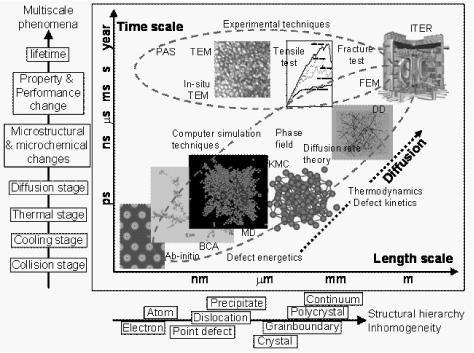Advanced Energy Structural Materials
Advanced Energy Conversion Division Advanced Energy Structural Materials Research Section
Associate Professor : Kazunori MORISHITA
Professor (Concurrent) : Yuhei MIYAUCHI
Innovative structural materials R&D with focusing on nano-meso structural control, and basic research for understanding materials performance and behavior.
Multiscale Modeling of Irradiation Processes of Fusion Materials
Many international programs are being underway for developing nuclear fusion reactors, which are one of the promising earth-friendly candidates for future energy sources. Material's issues are of critical importance, because reactors' integrity is basically determined by the component materials that suffer from severe irradiations. For developing irradiation-resistant materials, the database on materials' behavior during irradiation is required. However, they should reluctantly be obtained using the alternative, existing irradiation facilities such as fission reactors and ion accelerators, because of no actual fusion reactors at present. To overcome the difficulties caused by the difference between the two environments, a methodology to predict material's behavior in the actual environment using the existing materials' data is required. Our efforts have been made to establish the methodology. Molecular dynamics, kinetic Monte-carlo, ab-initio calculations, and rate-theory equations are powerful tools to understand radiation damage processes, which occur at a wide variety of time and length scales.
Multiscale radiation damage process
Radiation damage processes show different behavior depending on time- and length-scales that you are observing. To understand these multiscale phenomena, various investigation methods using computer simulations and experiments should complementarily be employed.

R&D of fusion reactor materials
We study the materials for divertor and blanket to realize fusion reactor. It is essential for fusion reactor to develop plasma facing material. Plasma facing material is used under the high heat flux and high energy particle irradiation such as neutron.
Especially, the property degradation due to the high energy particle irradiation (irradiation embrittlement) is one of the most important issues for lifetime of fusion blanket. It is required to predict the degradation for the design and economy. We study the irradiation embrittlement using an ion accelerator, DuET. DuET has two beam line, heavy ion beam and He ion beam, and it enable the irradiation experiment under the condition close to the fusion reactor. We join various domestic and international project to realize the fusion reactor.
Fundamental Studies of Energy-Materials Science and Technology
Lattice defects play an important role in the various issues and property changes in materials. Ion accelerator has been well known as the way to induce oversaturation point defects into materials and has contributed to the development of materials science. We study on the point defects in materials using the ion accelerator to elucidate the fundamental theory of materials science. Moreover, we develop the materials with higher or new properties by nano-meso microstructure control.









